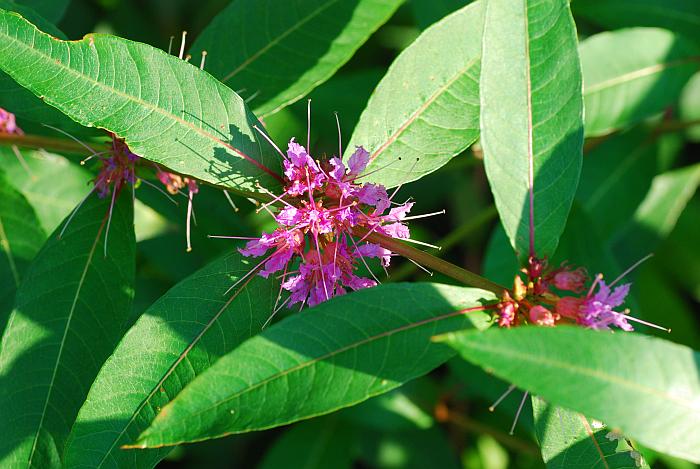Decodon verticillatus (L.) Elliott
Swamp Loosestrife

Native
CC = 10
CW = -5
MOC = 5
SRank = S1
© SRTurner
Decodon verticillatus (L.) ElliottSwamp Loosestrife | |
 |
Native CC = 10 CW = -5 MOC = 5 SRank = S1 |
© SRTurner |
|
Family - Lythraceae Habit - Shrubby perennial and strongly emergent aquatic, producing offshoots and hummocks of stems with age. Stems - Ascending and arching, to 2 m, woody at base, terete, often rooting at lower nodes, unbranched or sparsely branched except when rooting at tips, densely pubescent when young, becoming glabrous with age.
Leaves - Opposite or 3-4 whorled, short-petioled, simple, entire, to 20 cm, lanceolate or elliptic, sharply pointed, tapered at base, mostly glabrous above, pubescent below.
Inflorescences - Axillary clusters, each cluster short-stalked with few to several flowers, these on stalks to 11 mm long.
Flowers - Actinomorphic, with cup-shaped hypanthium 6-7 mm long. Calyx of 4-7 small, ascending, toothlike sepals on rim of hypanthium, these alternating with narrow appendages up to twice their length. Petals Usually 5, 9-15 mm long, reddish pink, tending to appear ruffled, not persistent at fruiting. Stamens 8-10, those of different flowers with filaments of potentially 3 different lengths (those of an individual flower usually of 2 lengths), the stamens exserted, the anthers yellow to yellowish brown. Pistil 1 per flower, with 3-locular ovary, the styles sometimes of different lengths in different flowers.
Fruits - Capsules 4-6 mm in diameter, globose, dehiscing longitudinally along 3 partitions between locules. Seeds numerous, 1.2-2.0 mm long, asymmetrically obpyramidal, the surface with a network of minute ridges, olive green to reddish brown (usually with a contrasting spot on 1 face).
Flowering - July - September. Habitat - Pond margins. Origin - Native to the U.S. Lookalikes - None. Other info. - This plant is uncommon in Missouri, with natural populations only reported from four counties thus far. It is far more common to our east, particularly in the upper Midwest and along the eastern seaboard. In Missouri, these plants have the peculiar habit of often growing on or among logs floating at the margins of swamps and ponds. When in flower it can be quite showy. The stems and seeds are a food source for muskrats and waterfowl. The "loosestrife" of the common name should not be confused with the "purple loosestrife" of invasive notoriety. Swamp loosestrife is a completely different, well-behaved, native plant. Photographs taken at Shaw Nature Reserve, Franklin County, MO, 7-23-2011, and Duck Creek Conservation Area, Stoddard County, MO, 8-12-2015 and 8-20-2024 (SRTurner). |